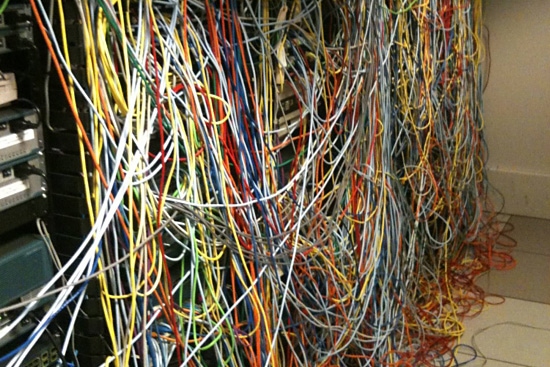While it’s never fun to have an office move, having a plan can make sure things go as fast and smooth as possible. Each Summer we help about a handful of clients move their IT infrastructures to new locations. We put together a full project plan and assign tasks for managing providers, cabling, equipment, etc. By fleshing out the project plan you can get a proper budget and timeline for all the moving pieces. The following are important items you don’t want to forget to plan for.
Network and Phone Cabling
A common misconception is that the electricians take care of the network and phone jacks in the office. The reality is that network and phone cabling is low voltage and typically handled by a different team. Furthermore, that team needs to work with your IT partner to properly plan the locations of the server/network closet, floor and wall jacks, and wireless access points which need cables as well.
During the planning of construction of your new office, the blueprints should be shared and discussed with you, the technology team, and the low voltage provider. Your IT partner should already have a trusted low voltage partner to team up with to plan and run the cables. These discussions will focus on where desks and equipment will go to help plan for phone locations, printers and copiers, wireless coverage, and wall displays and TVs that may need network connectivity.
The whole process takes about 2 months. From planning, to getting all the cables run, terminated, and fully tested will require several discussions and changes. Always make sure that your cabling is fully tested with a certification report provided at the end. This is the backbone of how your company communicates. Verify everything is good at the start to avoid a lot of headaches after the office move.

Internet Connectivity
While it seems obvious on the surface, many forget about Internet connectivity until the last minute. Most providers, like Comcast, require at least 2 weeks to install. Your partner may be able to expedite this but don’t bank on it. If you don’t have a remaining contract, simply setup service for the new location and you can take advantage of new promos for discounts. Once the install at the new office completes your IT partner can make sure it’s configured and working properly before you move in.
This is a great time to re-evaluate your bandwidth needs and discuss what might be needed for new technology you may want to be taking advantage of in the years to come. If you’re moving to VoIP, using video conferencing, or moving to a cloud infrastructure you need to plan out those bandwidth needs. Take advantage of those discounts on new service but don’t commit to any agreements longer than 2 years if you don’t have to. Technology evolves rapidly and so does pricing!
Your existing service will keep going without interruption and you can cancel it once the move completes. Having the new service in place allows everything to be configured in your network equipment when it gets physically moved to the new location. It becomes plug and play.
Equipment
Unless your office is exactly the same layout and size, you’re likely going to need some changes to your equipment. It’s also a good time to cleanup some not so nice items as well. For example, filthy looking keyboards, rats nest of cables, etc.

During the network and phones cabling planning, your IT partner will identify needs for wireless coverage as well as network switch capacity. This will determine if more switches are needed, how many patch cables to order (for the closet and user’s desks), and backup battery and rack capacity.
Wireless coverage is very environmentally sensitive. The team will want to head to the location to see what the construction of walls will be as well to run tests for interference with other offices and wireless devices. For instance, when moving from a small suburban office to a building in the center of Chicago, the interference difference is massive. We have seen clients go from 4 competing access points to 500. If not planned for and everything is moved as is, wireless can be unusable on day 1 after the office move.
Review your leases on copiers and plan for printing needs. If you’re growing the team does your existing print environment allow for expanded print volume? Are the printers and copiers fast enough?
Lastly, sort out who is moving the computers, accessories, and more. Some moving companies will take care of this for you and simply require devices be labeled and tagged for final desk locations. Others require you to handle this on your own. Your IT partner can help with this but plan for the discussion in advance of moving day.
While this is just a short list of office move must dos, I hope it helps start the discussions for planning of key items when your business moves. As a trusted IT partner for many Chicago area small businesses, our team at 101 Digital loves to help plan office moves.
